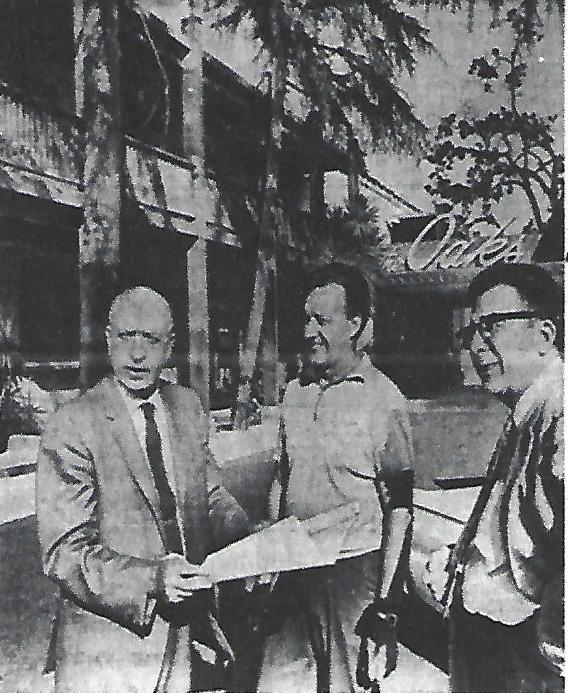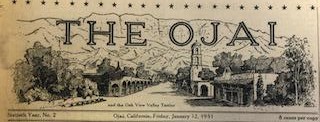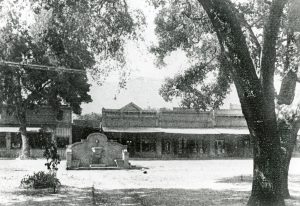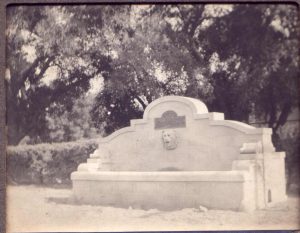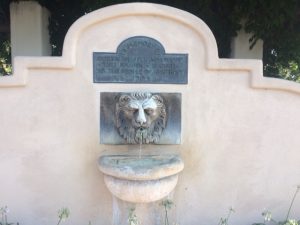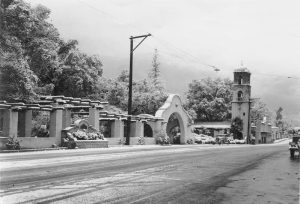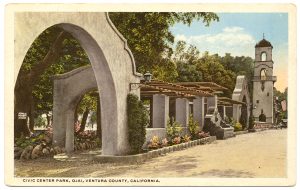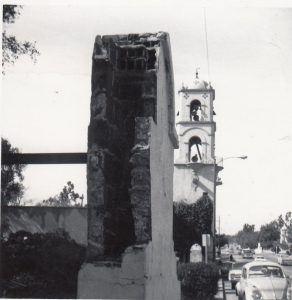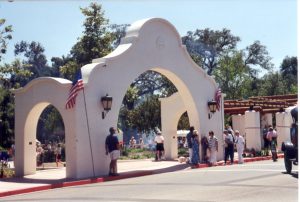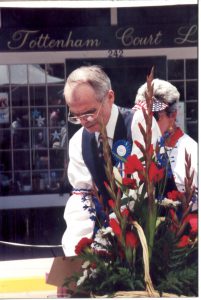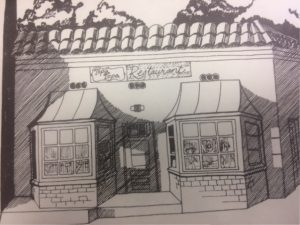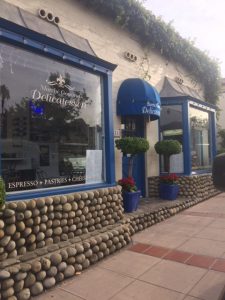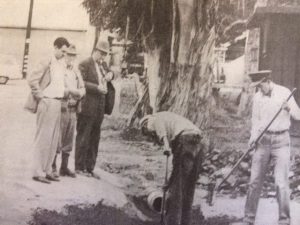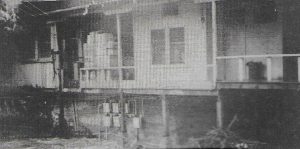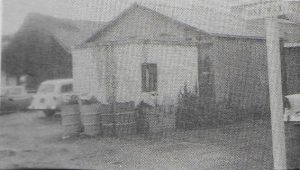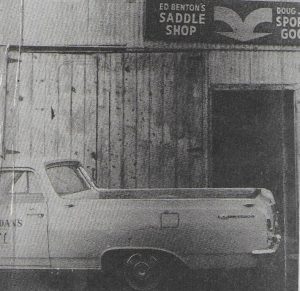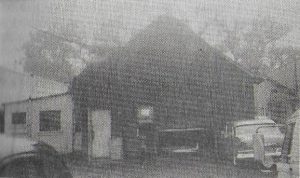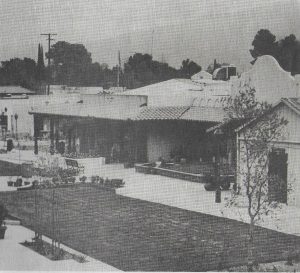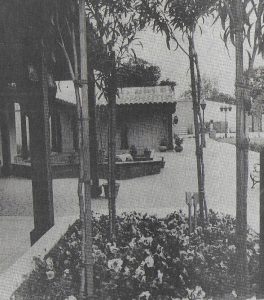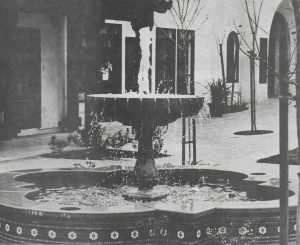This article was contributed by longtime Ojai Valley resident Susan Roland. Roland recently discovered this article in the belongings she inherited from her mother. The “Ojai Valley Museum” has added the photos to the article.
Hollywood glamour
Oaks history — never dull
[Much of the following history of the Oaks hotel was taken from a series of articles for the Ojai Valley News by the late Helen Davenport, in 1962 society editor of the OVN.]
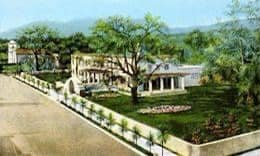
Staring as a quiet little country inn, the hotel opened around 1920 after many false starts and much talk. The ground was originally owned by P.K. Miller and he built a house on the site where he raised his family, according to Jennie Miller Griffin, his daughter.
The house burned down in the big fire of 1917.
A number of Ojai residents took an option on the property and became stockholders. These stockholders sold out at 50 cents on the dollar to Frank Barrington of Santa Barbara.
THE STORY GOES that the Barrington’s worked for a wealthy woman in Montecito, he as a butler and she as an upstairs maid. It is thought by others that she was a trained nurse. Both, it is true, were Irish and friendly. The wealthy woman ultimately died and left the couple $25,000 to run a hotel. Ojai was their destination.
Soon the hotel opened for business under the name of El Roblar.
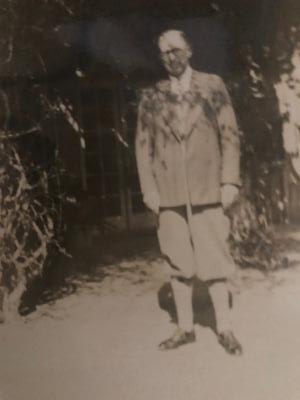
Mr. Barrington in front of the El Roblar on March 4, 1929.
Following the death of Mr. Barrington, his wife continued to operate the hotel for many years. She brought many of her relatives over from the old country to visit and work in the establishment. Local residents held parties there, because the Ojai Valley Inn at this time was a private club.
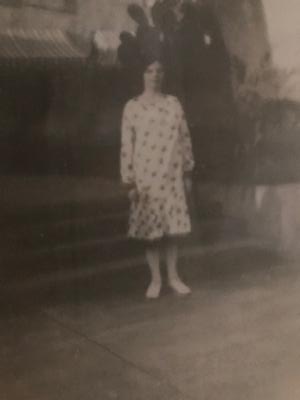
Mrs. Barrington in front of the El Roblar in March 1929.
Mrs. Barrington was neat and orderly and well-liked. She saw to it that flowers were in the rooms and on the tables. As was the custom of the time in many homes, she had doilies and tidies strewn around for the homey touch. She took flowers to the Presbyterian church for many years.
Frank Barrington is remembered as a man of graceful charm. The New Years’ Eve parties are well remembered when he served his famous eggnogs to carollers returning to the hotel at midnight — a touch of alcohol in them for adults, unspiked for the youngsters.
Chauffeur-driven cars drove around the orange trees to the front door, letting out passengers who returned many times to the year-round hotel.
FROM A QUIET little country inn — the Oaks hotel became an internationally known hostelry. Changes in ownership followed in rapid succession, some tragic, some happy.
Mrs. Barrington sold the hotel to Canfield Enterprises of Santa Barbara. Mr. and Mrs. Canfield took over with many plans for changes and expansion. But these were put to a tragic end with the unhappy suicide of Mr. Canfield.
This was followed by the ownership of the Oaks going to the Cromwells of San Francisco and once more the doors were open with eager anticipation of a great future. Plans had been completed for the Matilija dam and hopes were high for an expanded hotel to take care of the expected influx of engineers, visitors and fishermen. Once again these dreams were shattered by the suicide of Mr. Cromwell.
Mrs. Barrington again took over the hotel. She soon leased it to Richard Paige (presently living on McAndrew road). This time some of the dreams became a reality. Paige and Morgan Baker, his associate, built the first bar in the hotel. A small intimate room it soon became a sought-after meeting place for cocktails and after-party and theater gatherings. It was noted for its “rump rail” an innovation which allowed the weary drinker to slouch in an orderly fashion with elbows and derriere well supported.
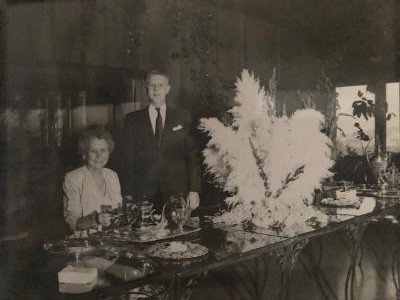
During the management of Paige and Baker, the present swimming pool was added to the Oaks attractions. Swim parties were frequent and the hotel became better-known than ever. The unhappiness of the previous years was completely forgotten behind the happy shouts from the bar and pool.
MANY STILL SPEAK of Martinez the bartender, who is said to have mixed a martini so memorable that people spoke of them in hushed and awed voices. They were, it is said, refused to those who were not regarded as worthy of such a mixture by the noble Martinez.
The management of Paige and Baker, as all things must, came to an end as these gentlemen became occupied elsewhere, and the Oaks — still owned by the Barrington estate — again sought ownership and management.
In 1952 the hotel was bought by Frank Keenan and the hotel entered into an era of splendor and activity it had not known before. Keenan was a former county assessor for Cook County, Ill., which is largely taken up by the city of Chicago, and he had glamorous plans for the hotel which he promptly began to carry out.
The present cottages around the pool were built and were soon filled with some of the most glamorous names of Hollywood and New York and less desirable places. Gangster Bugsy Siegal was a visitor. The dining room was remodeled and the bar enlarged. Keenan brought his genial brother Jim to act as host.
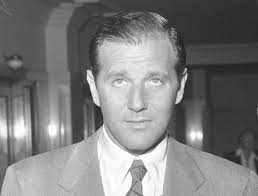
Benjamin “Bugsy” Siegel
THE DINING ROOM was named the Chicago room and was greatly sought-after as a meeting place for important groups and glittering with social affairs. The opening with Bud Abbott as M.C. was rumored to cost $10,000. Guests arrived from all over the country and local residents who were lucky enough to be included talked endlessly about the gala affair.
It was during the Keenan ownership that the Oaks took on its present shape and form (that was 1962). The Keenan brothers wide acquaintance brought distinguished guests — and some who had glamour. Nevertheless, it was noted for its quiet dignity, fine cuisine and genuine hospitality.
It was said that Keenan wanted to make the Oaks into a casino a la Las Vegas. City officials who requested their names be withheld remember being approached with propositions and requests for “protection”. These officials let it be known that no gambling would be allowed in Ojai and this particular project was dropped.
The future of the Oaks was suddenly thrown into doubt when after four years of gaiety the Keenan brothers were indicted for income tax evasion back in Illinois. They were convicted and sent to prison.
The genial Jim Keenan died in prison; Frank Keenan completed his term and many hoped he would again resume ownership of the Oaks.
ONCE AGAIN the hotel closed and the halls were hushed. They remained quiet for over a year.
Through Keenan’s attorney, the hotel came into the hands of Heiress Lolita Armour (of Chicago packing house fame) and her new young husband Charles Madrin. It was thought that the hotel was being used as a tax write-off. A deal was made to trade the Armour estate in Lake Forest, Ill. for the Oaks hotel and once again the closed sign was removed.
On Jan. 1, 1958, a new regime started — one of toil and trouble — and a series of managers followed. There were seven in a two-year period before closing early in 1962.
Civic organizations held meetings at the hotel, lunches and dinners set by local residents, dinner dances were held, and the Wednesday style show around the pool were attractions. One manager installed electric heat lamps to be used on the terrace when the sun failed. A key-holders club was formed to make residents use the pool and bar and Richard Blalock’s orchestra played in the large dining room. Honeymooners loved the quiet of the mid-week and Hollywood celebrities dropped in for a rest in the country. Conventions were booked, but accommodations were such that only small crowds could be handled. The hotel was also the hub of the town. Genial Gino Giamari held sway as head bartender.
On the debit side, the various managers made many mistakes. One called an employees meeting once each month, however it was soon seen that those who got up to talk were soon fired. Another imbibed too much, another hated music and called the bartender when the lounge was filled with local people listening to a $ 150-a-week pianist. The bartender was sent home and the patrons left.
The thing the employees hated most was the Las Vegas mirror installed above the bar. Some thought this was not only to check on the bartender but on the low-cut gowns of the ladies. Along with the mirror a complete intercom system was put in, one that could be reversed so that employees’ every whispered word could be checked.
IN FEBRUARY OF 1962 the American Association of Retired Persons (Grey Gables) took a 90-day option on the Oaks, planning to sell units to its members. The price was around $500,000. However, the deal never closed because of the high expense of fireproofing and bringing the aging structure up to the building codes.
The Oaks remained closed for a while in 1962-63 until it was taken over by a well-remembered Ojai valley figure — Santa Barbaran Vernon Johnson. A big, bluff, bearded extrovert, who worked as a telephone company lineman-foreman and still does. Johnson had come into an inheritance and “had always wanted to run a hotel”. Several years prior to this, he had gained a measure of fame when he toured ’round the world (including through Siberia) in a converted Greyhound bus with his wife and 9 children. He bought the mortgage from Lolita Armour for $295,000 — making a $50,000 cash payment.
JOHNSON PLAYED a genial host at these parties, circulating from table to table with stories and goodwill. “He” became, in essence, the Oaks hotel and his face appeared on the menus, on the paper napkins, matchbook covers and even the tiny bar soap wrappers.
Localites were impressed with Johnson who went to Los Angeles one day and bought a $3,000 rare Macaw bird and installed it in the lounge.
Johnson lasted a year before filing for bankruptcy. Henry Coulson, a federal bankruptcy referee living in Ventura, then had the unhappy task of keeping the Oaks open and alive, which he did without the benefit of hotel experience until the Oaks was bought by a local group, headed by Rodney Walker and Jerald Peterson, at an auction in Nov. of 1966 for $230,000.
